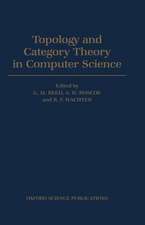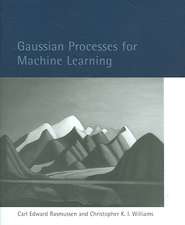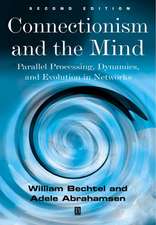Talking with Computers in Natural Language
Traducere de Tomasz R. Werner Autor Eduard V. Popoven Limba Engleză Paperback – 16 noi 2011
Preț: 649.09 lei
Preț vechi: 811.37 lei
-20% Nou
Puncte Express: 974
Preț estimativ în valută:
124.20€ • 130.03$ • 102.77£
124.20€ • 130.03$ • 102.77£
Carte tipărită la comandă
Livrare economică 05-19 aprilie
Preluare comenzi: 021 569.72.76
Specificații
ISBN-13: 9783642710841
ISBN-10: 3642710840
Pagini: 324
Ilustrații: XII, 308 p.
Dimensiuni: 170 x 244 x 17 mm
Greutate: 0.52 kg
Ediția:Softcover reprint of the original 1st ed. 1986
Editura: Springer Berlin, Heidelberg
Colecția Springer
Locul publicării:Berlin, Heidelberg, Germany
ISBN-10: 3642710840
Pagini: 324
Ilustrații: XII, 308 p.
Dimensiuni: 170 x 244 x 17 mm
Greutate: 0.52 kg
Ediția:Softcover reprint of the original 1st ed. 1986
Editura: Springer Berlin, Heidelberg
Colecția Springer
Locul publicării:Berlin, Heidelberg, Germany
Public țintă
ResearchDescriere
The growing efficiency and lower prices of computers make it possible to apply them more widely in the economy. However, the wide use of computers in every day life is hindered by a number of factors which constitute what we shall call the "problem of contact" or of "talking". The difficulty is that languages used by computers differ substantially from users' languages and are not understood by specialists who are unfamiliar with programming. This is why those specialists who use computers need the help of programmers to communicate. Since this form of communication has many more or less obvious shortcomings, great efforts have been made to find a solution to the problem of contact. Two ap proaches can be distinguished here: (1) making the computer language similar to the natural language; (2) making the user's language resemble that of computers through formalizing the former. This book deals with the first approach. We shall consider those systems which make it possible to "talk" with the user in limited natural language (LNL). The term "natural language" (NL) has been used in the title of this book instead of LNL. The reason for not using the term "limited natural language" is that this term has two meanings: (1) a dialect of a natural language; (2) a formal language whose operators are expressed by words taken from a natural language (e. g.
Cuprins
1 Theories and Principles of Designing the Model of Conversation.- 1.1 Main Characteristics of the Process of Conversation.- 1.2 An Analysis of Existing Linguistic Models.- 1.3 Principles of the Model of Conversation.- 2 Principles of Construction and General Organization of the Model of a Participant in the Conversation.- 2.1 Initial Premises for Designing the Model of a Participant in the Conversation.- 2.2 Problems Connected with the Model of a Participant in the Conversation.- 2.3 Existing Systems of Conversation.- 2.4 Composition and Structure of the Model of a Participant in the Conversation.- 2.5 General Structure of the Model of a Participant in the Conversation.- 3 The Structure of Knowledge and Methods of Representing Reality: Knowledge About the Surrounding Environment.- 3.1 WHAT Is to Be Represented and HOW?.- 3.2 The Model of the Surrounding Environment — Preliminary Notions.- 3.3 Structure of Knowledge of the Surroundings.- 3.4 Classification of Methods of Representing Knowledge.- 3.5 Representing Knowledge About the Model of the Surrounding Environment.- 4 The System’s Knowledge About the Language and the Participants in the Conversation.- 4.1 Connected Text and Linguistic Concordances.- 4.2 Knowledge About the Language of Conversation.- 4.3 Representation of Individual (Dictionary) Pieces of Knowledge About Language.- 4.4 Knowledge About the System Itself: Methods of Representing This Knowledge.- 4.5 Knowledge of the User.- 5 Input Sentence Analysis.- 5.1 General Outline.- 5.2 Morphological Analysis of Word Forms: Presyntax.- 5.3 Syntactic Sentence Analysis.- 5.4 Semantic Analysis of a Sentence (SEAS).- 6 Connected-Text (Discourse) Processing.- 6.1 General Structure.- 6.2 Determining the Linguistically Expressible Interdependencies Between Sentences in a Discourse.- 6.3 Context and Its Role in Discourse Processing.- 6.4 Interpretation of an Input Text: Inferring.- 7 Synthesis of Statements in Natural Language.- 7.1 General Model of Synthesizing Texts.- 7.2 Semantic Synthesis of the Graph of an Answer.- 7.3 Syntactic Synthesis of an Output Sentence.- 7.4 Morphological Synthesis of the Word Forms of the Sentence Being Synthesized.- 8 Work to Date on Designing Systems of Conversation.- 8.1 General Outline of the POET System.- 8.2 Representation of Knowledge in the POET System.- 8.3 Practical Operations of the POET System.- 8.4 The POET System as a Means of Automatically Describing Inquiries and Documents.- Epilogue.- References.











